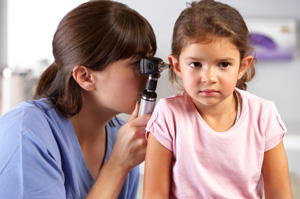Ear infections are one of the most common illnesses reported in young children.
 Otitis media is the medical term for inflammation of the middle ear that is accompanied by fluid build-up. When fluid accumulates in the middle ear space it prevents the tiny bones inside the ear from moving properly. This prevents sound from being conducted and hearing may be impaired until the fluid clears.
Otitis media is the medical term for inflammation of the middle ear that is accompanied by fluid build-up. When fluid accumulates in the middle ear space it prevents the tiny bones inside the ear from moving properly. This prevents sound from being conducted and hearing may be impaired until the fluid clears.
Children are more susceptible to ear infections because of the location of their ear canal. Until the age of 6 or 7 years, a child’s Eustachian tube (the tube from the ear to the back of the mouth) is small and horizontal, making it susceptible to fluid build-up. Once the skull begins to mature and grow the Eustachian tube becomes more vertical in position and more natural drainage takes place.
Middle ear infections can impact hearing in a range of ways. Some children may experience no hearing loss, whereas others may have mild or moderate hearing loss. A mild hearing loss means that faint or soft sounds like “S”, “SH” or the ending sounds of words are not heard. A moderate hearing loss means not hearing most speech sounds and word endings
Think about what it is like when your ears are plugged or you are trying to listen to sounds under water. This muffled input is similar to what a child perceives when they have an ear infection or fluid in their ear canal. This can have a negative effect on a child’s ability to understand language and sort out speech sounds.
A child with recurrent ear infections experiences temporary impairment of hearing with each bout. Research studies report that fluid build-up can persist for up to 6 weeks after the ear infection has resolved. Not hearing adequately for a span of 7-10 weeks on a repeated basis can have a significant negative impact on the development of speech and language skills.
Children experiencing ear infections or fluid build-up should be closely monitored for any signs of speech and language delay. Prevention, early recognition and treatment of ear infections is important
Preventing Ear Infections
Children with repeated ear infections may not develop speech and language skills at the typical rate. While you may not be able to prevent all ear infections there are some things you should know and try:
- Keep your baby & toddler sitting up to drink – at least 45 degree angle. This will lessen the chance of liquid backing up and sitting in the Eustachian tube.
- Breastfeed your baby to prevent ear infections. Typically the position is more upright and the benefit that breast milk provides your baby’s immune system helps prevent infections.
- When your child does have a cold, try to keep their nose clear of fluid to decrease back-up into the Eustachian tube.
- Boost your child’s immune system by maintaining a healthy diet.
Recognize ear infection symptoms early:
Ear infections can occur long before a child is able to say: “my ear is hurting”. Some children may not always experience pain. It is important to watch your child’s behavior for the following signs:
- Pulling, rubbing or scratching their ear more often
- Fever, changes in sleeping or eating habits
- Delayed or reduced response to speech and everyday sounds
- Having difficulty keeping balance, running or jumping
- May seem more tired, inattentive, listless or generally irritable
- May ask to have music or television louder than usual
- Needs to have directions or questions repeated
- Talking less than usual
- If you see any of these signs, talk with your family doctor
How to help your child communicate when hearing is reduced:
If you know or suspect that your child has an ear infection think about trying to alleviate communication frustration by using these techniques:
- Get your child’s attention before you talk
- Get down to your child’s eye level
- Reduce background noise (radio/TV/other voices)
- Use body language, gestures or early sign language to help your child understand
The first few years of life are critical for the development of speech, language and communication skills. Not all children with ear infections have speech and language delay, however, 1/3 of children receiving therapy for speech and language delay have a reported history of recurrent ear infections.
It is important to watch your child for any signs or symptoms of speech and language delay. The tykeTALK Communication Development Checklist is a great resource for information on normal speech and language milestone expectations.
Article authored by Janice Mervyn M.H.Sc., B.Ed. Reg. CASLPO, Speech Language Pathologist, First Words Preschool Speech and Language Program; re-produced with permission





